
Why should I care for my pet’s teeth at home?
As your pet is unable to care for his/her own dental hygiene, it is important that we, as owners assume that responsibility. As the pet eats, plaque (a sticky film containing bacteria) forms over the surface of the tooth, and if this is not removed with manual brushing, then it will harden and become tartar (which can only be removed with ultrasonic scaling). If left untreated tartar can lead to periodontal disease, secondary infection and eventually bone loss and tooth loss. Dental disease can also have systemic implications and lead to poor general health and even liver, kidney and heart disease.
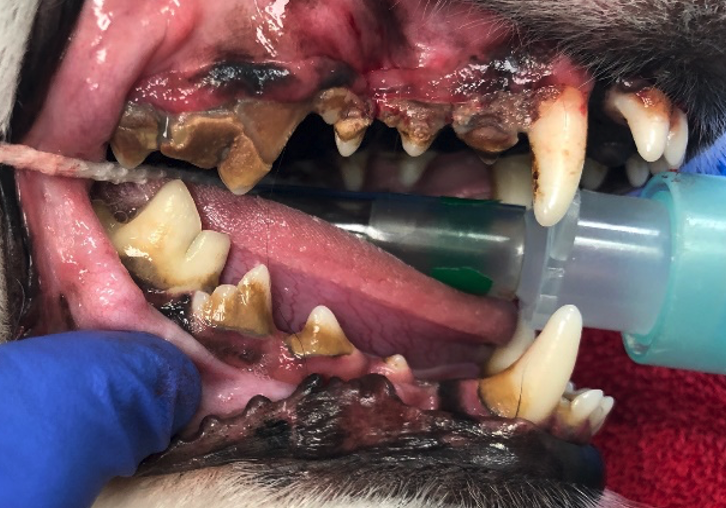
How do I get my pet used to oral care at home?
Brushing is by far the best method of keeping your pet’s teeth clean, this is best accepted by pets if introduced very slowly and gently.
Stage 1: Building Confidence
- First sit in a position that both you and the pet are comfortable, (for larger dogs have them sitting on the floor between your knees, for smaller dogs or cats, a raised bench or table may be easier).
- Gently rub the pet’s face and muzzle with your finger only.
- Work up to being able to gently hold the mouth closed for a short period.
- This can be done by placing fingers on top of the nose, or muzzle, with the thumb under the chin.
- Do this for approximately 30 seconds and then reward with fuss, play, a treat, or all of the above.
- Repeat daily for at least five days or until your pet is relaxed and comfortable with this, before moving on to the next stage.
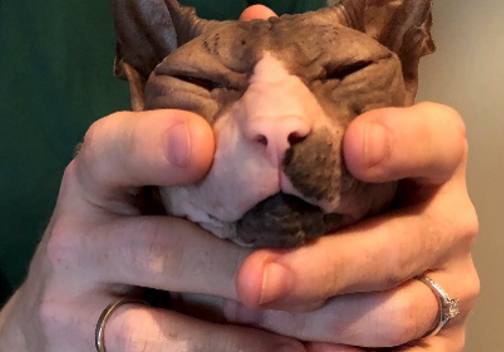
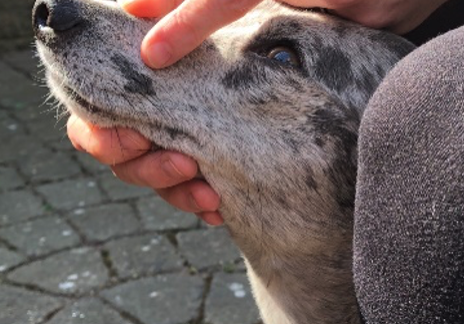
Stage 2: Finger brushing
- It is very important to source pet specific toothpaste; human toothpaste contains fluoride which is toxic to pets if swallowed (safe products can be sourced through most good pet shops or via the practice).
- Position yourself as you have been for confidence building then gently close the mouth with the lips relaxed.
- Apply a pea sized quantity of toothpaste to the end of your index finger and gently slide this finger under the pet’s upper lip (being aware that this could startle the pet the first time you try).
- Give him/her a moment to get used to the sensation and then gently slide your finger along his teeth starting at the large upper canine (fang) tooth and working backwards.
- Some pets may find the small front incisor teeth sensitive so only attempt to brush these when the pet is comfortable with all other teeth.
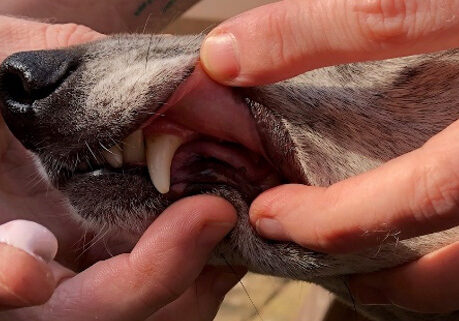
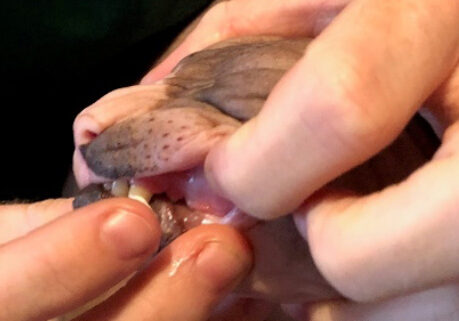
A proportion of cats (and some dogs) will not tolerate anything past this stage, While dental hygiene is very important, do not risk your safety, if you see signs of your pet getting very stressed despite this initial desensitisation period, it may be preferable to use gels, rinses or dental chews for your pet instead
Stage 3: moving up to a toothbrush
- A toddler’s soft bristled toothbrush is a perfect starting brush for most sizes of pets. Once confident with this, electric toothbrushes are surprisingly well tolerated, particularly in larger dogs and those that are not concerned about noise.
- Place a small amount of pet friendly tooth paste on to the brush and slip the brush under the pet’s upper lip as practiced with your finger.
- If you are right-handed, it is easier to brush the left side of your pet’s mouth. For this reason, we recommend working hard to ensure that both sides of the mouth are equally brushed
- When you start brushing you may notice a small amount of blood on the brush, this will stop appearing as you will be tackling the gum disease responsible for the bleeding.
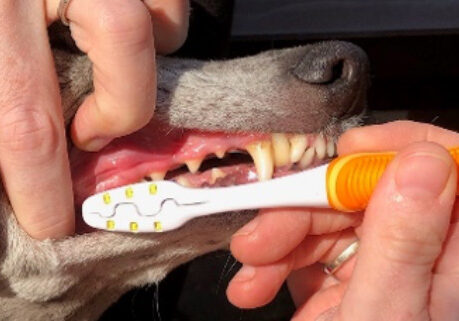
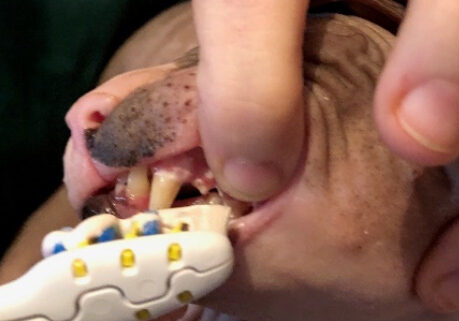
Other options for oral care
Brushing is the premium method of keeping your pet’s teeth healthy, however, we understand that not every pet will tolerate this therefore there are some additional things that can be used to help keep teeth and gums healthy such as gels, rinses, diets and dental chews.
Specialist Diets
The majority of dental specific diets are complete dry biscuit diets. They can be used in conjunction with brushing. The biscuit size, shape and texture is formulated to provide an increased abrasive action, in comparison to standard dry diets, which helps to reduce tartar formation. Additionally, these diets contain a molecule (pentasodium triphosphate) that reduces the formation of tartar on the tooth’s surface.
Just as important as good hygiene is recognising signs of disease. As you spend time caring for your pet’s mouth, you become familiar with “what is normal” making abnormalities much easier to spot. Look out for any loose or discoloured teeth (grey or purple colour to the crown). Also look for any discharge from the base of the tooth, excessive bleeding or fractures/cracks.

Gels and Oral Rinses
These products contain chlorhexidine which is effective in killing bacteria in the mouth. It is these bacteria that form the plaque which goes on to damage teeth and gums. Chlorhexidine also has a residual effect which continues to fight bacteria for 18 hours after application. Gel products are beneficial in pets that suffer from or are likely to develop gum disease and can also be beneficial in cats where brushing is not tolerated as they can be applied with a cotton bud and may allow progression to a toothbrush. Oral rinses are especially useful if gums are too sore to brush, especially immediately after a dental treatment. Both gels and oral rinses are to be used on a daily basis. Specific instructions will be given for individual pets, however usually a small volume (1 – 5mls) is flushed into the mouth with a syringe twice daily.
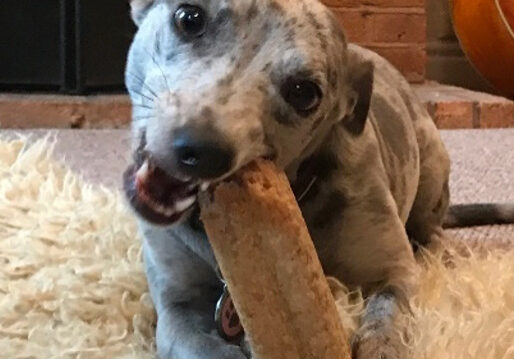
Dental Chews
Dental chews may help to reduce plaque accumulation and tartar formation on teeth, and pets love the taste, which is reason enough to give them. Do not rely on them alone in your pet’s dental care regime as current evidence indicates that chews alone, as a method of cleaning, are not capable of maintaining long term oral health.
It is also important to be aware of the caloric content of some dental chews and reduce the pet’s total daily intake accordingly, some of these chews can be very high in fat and cause pets to gain a lot of weight very quickly.
Other concerns
It is very important to note that your Vet will always be happy to discuss any concerns that you may have regarding the oral hygiene of your pet. Insurance companies recommend that your pet has an oral health check at least once every 12 months and that any dental work that is recommended by a veterinary surgeon be carried out within three months to be covered by your policy. If you have any questions or concerns, please do not hesitate to call the practice and we will be more than happy to answer any queries for you.
Pet Health Information
Find out more
To assist owners in understanding more about a general pet health conditions we have put together a range of information sheets to talk you through some of the more common health concerns seen and treated by our General Practice Vets.

